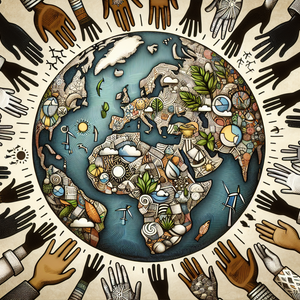Beyond the Horizon: How Drones are Transforming Environmental Careers

One of the most significant applications of drones in environmental science is in monitoring ecosystems and wildlife. Drones equipped with high-resolution cameras and sensors can survey vast areas in a fraction of the time it would take a ground team. This technology allows for real-time data collection on wildlife populations, habitat conditions, and environmental changes. For example, researchers studying endangered species can use drones to monitor animal movements without disturbing their natural behavior. A study conducted by the University of Queensland demonstrated how drones could effectively track the nesting habits of sea turtles along the Australian coast, providing valuable insights into their breeding patterns and the impact of human activities on their habitats. This ability to gather data quickly and accurately is invaluable, contributing to better conservation strategies and promoting wildlife protection.
Precision Agriculture and Land Management
The agricultural sector is also experiencing a transformation thanks to drone technology. Drones are increasingly being used for precision agriculture, where farmers use aerial imagery to monitor crop health, assess soil conditions, and optimize resource use. By providing detailed insights into crop performance, drones allow for targeted interventions, reducing waste and increasing yield. A prime example comes from the use of drones in vineyards. Winemakers are employing drones to assess grape health and optimize irrigation practices. By analyzing aerial images, they can identify areas of stress in the vineyard and apply resources accordingly, leading to better quality grapes and, ultimately, superior wine. This shift not only boosts productivity but also promotes sustainable farming practices, aligning agricultural practices with environmental conservation.
Climate Change Research and Disaster Response
Drones play a crucial role in climate change research and disaster response efforts. They can be deployed to collect data in areas that are difficult to access due to natural disasters, such as floods or wildfires. Drones can quickly assess damage, provide situational awareness, and help in planning recovery efforts. For instance, after Hurricane Harvey devastated parts of Texas, drones were used to capture aerial footage of the affected areas, allowing responders to evaluate the extent of the damage and prioritize relief efforts. Additionally, environmental scientists are using drones to monitor glaciers and track changes in ice mass, providing critical data needed to understand the impacts of climate change. This innovative use of drone technology not only enhances response efficiency but also contributes to comprehensive studies on climate change.
Skills for the Future
As the demand for drone technology in environmental careers grows, so does the need for professionals who possess specialized skills. Environmental scientists must now be adept at operating drones, analyzing aerial data, and understanding the software used for processing images and generating reports. Knowledge of Geographic Information Systems (GIS) is also increasingly valuable, as it allows scientists to visualize and interpret spatial data. Moreover, professionals in this field need to maintain a strong foundation in ecological principles and environmental science to ensure that the data collected is relevant and actionable. As this intersection of technology and science continues to evolve, educational programs and training opportunities will need to adapt, focusing on integrating drone technology into environmental studies. This adaptation will prepare the next generation of environmental professionals for the challenges and opportunities that lie ahead.
Drones are undeniably transforming environmental careers, providing new tools and methodologies that improve data collection, enhance monitoring capabilities, and facilitate better decision-making in conservation and land management. As this technology continues to develop, professionals in the environmental field must embrace these changes and cultivate the necessary skills to thrive. The future of environmental science is soaring to new heights, and those who harness the power of drones will be at the forefront of this exciting evolution, making significant contributions to the sustainability of our planet.
Drone Environmental Scientist
Environmental consulting firms, wildlife conservation organizations, government agencies
Core Responsibilities
Conduct aerial surveys and monitor ecosystems using drone technology.
Analyze data collected from drone flights to assess wildlife populations and habitat conditions.
Collaborate with conservation organizations to develop effective wildlife protection strategies.
Required Skills
Proficiency in drone operation and aerial data analysis.
Strong background in ecology and environmental science.
Familiarity with Geographic Information Systems (GIS) for spatial data visualization.
Precision Agriculture Specialist
Agricultural technology companies, large-scale farms, agricultural cooperatives
Core Responsibilities
Utilize drones to monitor crop health and assess soil conditions for agricultural optimization.
Analyze aerial imagery to identify areas requiring targeted interventions.
Work with farmers to implement sustainable farming practices based on drone data insights.
Required Skills
Understanding of agricultural science and crop management.
Experience with drone technology and agricultural software tools.
Strong analytical skills to interpret data and make recommendations.
Drone Data Analyst
Research institutions, environmental NGOs, consulting firms
Core Responsibilities
Process and analyze aerial imagery collected by drones for environmental assessments.
Generate reports and visualizations to communicate findings to stakeholders.
Collaborate with environmental scientists to refine data collection methodologies.
Required Skills
Proficiency in data analysis tools and software (e.g., GIS, remote sensing software).
Strong attention to detail with a focus on data accuracy and integrity.
Ability to translate complex data into actionable insights for non-technical audiences.
Disaster Response Coordinator
Government disaster response agencies, humanitarian organizations, consulting firms
Core Responsibilities
Plan and execute drone missions to assess damage in disaster-affected areas.
Coordinate with emergency services and NGOs to prioritize relief efforts based on drone data.
Develop strategies for integrating drone technology into disaster response protocols.
Required Skills
Experience in emergency management and disaster response.
Knowledge of drone operation and aerial data interpretation.
Strong communication and organizational skills to manage multi-agency collaborations.
Environmental Policy Analyst (Drone Technology Focus)
Government agencies, think tanks, environmental advocacy groups
Core Responsibilities
Research and analyze the implications of drone usage in environmental monitoring and management.
Develop policy recommendations for the responsible use of drones in conservation efforts.
Engage with stakeholders to promote best practices in drone technology application.
Required Skills
Strong understanding of environmental policy and regulations.
Ability to synthesize technical information into policy frameworks.
Experience in stakeholder engagement and advocacy.


